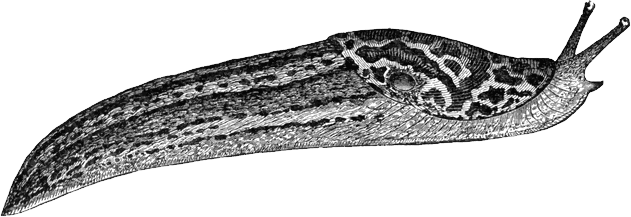
This image has format transparent PNG with resolution 631x217.
You can download this image in best resolution from this page and use it for design and web design.
Slug PNG with transparent background you can download for free, just click on download button.
Slug, or land slug, is a common name for any apparently shell-less terrestrial gastropod mollusc. The word slug is also often used as part of the common name of any gastropod mollusc that has no shell, a very reduced shell, or only a small internal shell, particularly sea slugs and semislugs (this is in contrast to the common name snail, which applies to gastropods that have a coiled shell large enough that the animal can fully retract its soft parts into the shell).
Various taxonomic families of land slugs form part of several quite different evolutionary lineages, which also include snails. Thus, the various families of slugs are not closely related, despite a superficial similarity in the overall body form. The shell-less condition has arisen many times independently during the evolutionary past, and thus the category "slug" is a polyphyletic one.
Slugs' bodies are made up mostly of water and, without a full-sized shell, their soft tissues are prone to desiccation. They must generate protective mucus to survive. Many species are most active just after rain because of the moist ground. In drier conditions, they hide in damp places such as under tree bark, fallen logs, rocks and man-made structures, such as planters, to help retain body moisture. Like all other gastropods, they undergo torsion (a 180° twisting of the internal organs) during development. Internally, slug anatomy clearly shows the effects of this rotation—but externally, the bodies of slugs appear more or less symmetrical, except for the positioning of the pneumostome, which is on one side of the animal, normally the right-hand side.
Slugs produce two types of mucus: one is thin and watery, and the other thick and sticky. Both kinds are hygroscopic. The thin mucus spreads from the foot's centre to its edges, whereas the thick mucus spreads from front to back. Slugs also produce thick mucus that coats the whole body of the animal. The mucus secreted by the foot contains fibres that help prevent the slug from slipping down vertical surfaces. The "slime trail" a slug leaves behind has some secondary effects: other slugs coming across a slime trail can recognise the slime trail as produced by one of the same species, which is useful in finding a mate. Following a slime trail is also part of the hunting behaviour of some carnivorous slugs. Body mucus provides some protection against predators, as it can make the slug hard to pick up and hold by a bird's beak, for example, and the mucus itself can be distasteful. Some species of slug, such as Limax maximus, secrete slime cords to suspend a pair during copulation.
In this clipart you can download free PNG images: Slug PNG images free download